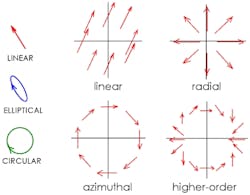New mathematical description of polarization could lead to higher fiber-optic data rates
New York, NY--A new way to describe polarized light makes it easier to work with, and potentially exploit, higher-order modes in data-transmitting optical fibers.1 Developed at the City College of New York (CCNY) and the Institute of Ultrafast Spectroscopy, the method expands on the use of the century-old concept of the Poincaré sphere for depicting polarization. The new mathematical approach is called a higher order Poincaré sphere (HOPS).
Taking orbital angular momentum into account
Light uniformly polarized across a beam can carry angular momentum through elliptical or circular polarization (see figure). But polarization can be spatially varied across a beam to add a different form of angular momentum (orbital angular momentum) that can be useful, for example, in optical tweezers.
In addition, in fiber-optic communications, some of these higher-order forms of polarizations could, in the future, be used to carry a higher rate of information down an optical fiber. “People now can detect (light in) the ground channel, but this gives way to detect and measure a higher number of channels,” says Giovanni Milione, one of the researchers. With such heavy traffic funneled through a single channel there is great interest in exploiting the others that can be occupied by complex forms of light, he explains.
The CCNY researchers' description of polarization, which includes orbital angular momentum, uses the HOPS to reduce what could be pages of mathematics to single equations--essential for adoption by technology. “The sphere facilitates understanding, showing phase vortices are on poles and vector beams are on the equator,” explains Milione. “It organizes the relationship between these vortices of light.”
Milione will present the team's work at the Optical Society’s "Frontiers in Optics 2011" conference (October 16-20, 2011; San Jose, CA).
REFERENCE:
1. G. Milione et al., Physical Review Letters 107, 053601 (2011).

John Wallace | Senior Technical Editor (1998-2022)
John Wallace was with Laser Focus World for nearly 25 years, retiring in late June 2022. He obtained a bachelor's degree in mechanical engineering and physics at Rutgers University and a master's in optical engineering at the University of Rochester. Before becoming an editor, John worked as an engineer at RCA, Exxon, Eastman Kodak, and GCA Corporation.
